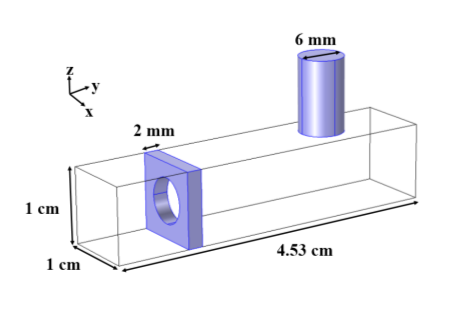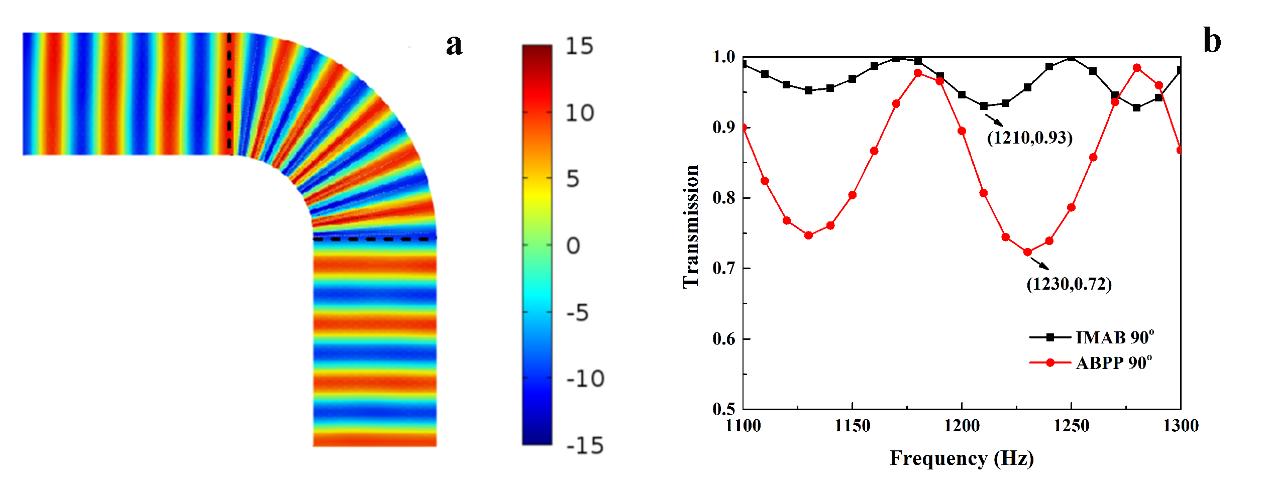The acoustic bend is designed to guarantee the wave modes in a waveguide containing a bend. Usually, reflections from the side walls of the waveguide will distort the wavefront and the wave modes will become chaotic in the bending area. A great deal of research work has been conducted in optical bends to solve this problem.
However, the principle and design of acoustic bends need a further investigation, which may have great potential applications in sound absorption and detection in pipelines.
Now, a research team from the Institute of Acoustics (IOA) of the Chinese Academy of Sciences designs an impedance-matching acoustic bend with perforated plates and side pipes, which can improve impedance ratio and increases energy transmission.
In an acoustic bend, the refractive index varies along with the radial direction. The smooth bending effect is derived from the continuous variation of the refractive index. In addition, impedance match is very important for complete transmission of the acoustic bend. Otherwise reflections at both the incident surface and the exit surface will reduce the energy transmission in the case of impedance mismatch.
In this research, the mass density and the bulk modulus of the structure are modulated simultaneously to make sure that both the refractive index and the impedance meet the requirement.
The research team uses two kinds of unit cells to modulate the mass density and the bulk modulus independently, and then combine these two unit cells into a new complex unit cell that can modulate both the mass density and the bulk modulus effectively, as shown in Fig. 1.
Researchers adopt retrieval method, which is useful in the design of acoustic metamaterials, to retrieve the effective parameters of these unit cells. In this well-developed retrieval method, the effective parameters are calculated from the reflection and transmission coefficients of a plane wave that is normally incident on the metamaterial.

Fig. 1 Schematic of the complex unit cell (Image by IOA)
The whole structure is divided into 59 arc-shape layers and each layer contains 30 periodic unit cells along its circumferential direction. At last, the sound waves can propagate through the bend area smoothly, and the transmission is higher than 93% in the frequency range from 1100Hz to 1300Hz, as shown in Fig. 2.

Fig. 2 Numerical simulation of the impedance-matching acoustic bend (Image by IOA)
Previously, this research team had represented an acoustic bend composed of perforated plates only. The results of this earlier research were published in The Journal of the Acoustical society of America (Volume 142, July 2017).
This research team from the Institute of Acoustics of the Chinese Academy of Sciences which focuses on the metamaterial is led by Prof. YANG Jun and Dr. JIA Han. Prof. YANG Jun engages in the researches on sound, vibration and signal processing, especially in sound field control and array signal processing. They also make efforts in other devices based on metamaterial to manipulate the propagation of the sound wave. They believe the metamaterial will spread widely in the future.
Reference:
YANG Yuzhen, JIA Han, LU Wenjia, SUN Zhaoyong, YANG Jun. Impedance-Matching Acoustic Bend Composed of Perforated Plates and Side Pipes. Journal of Applied Physics 122, Article number: 054502 (2017). DOI: 10.1063/1.4996848
Contact:
YANG Jun
Key Laboratory of Noise and Vibration Research, Institute of Acoustics, Chinese Academy of Sciences, 100190 Beijing, China
E-mail: jyang@mail.ioa.ac.cn


